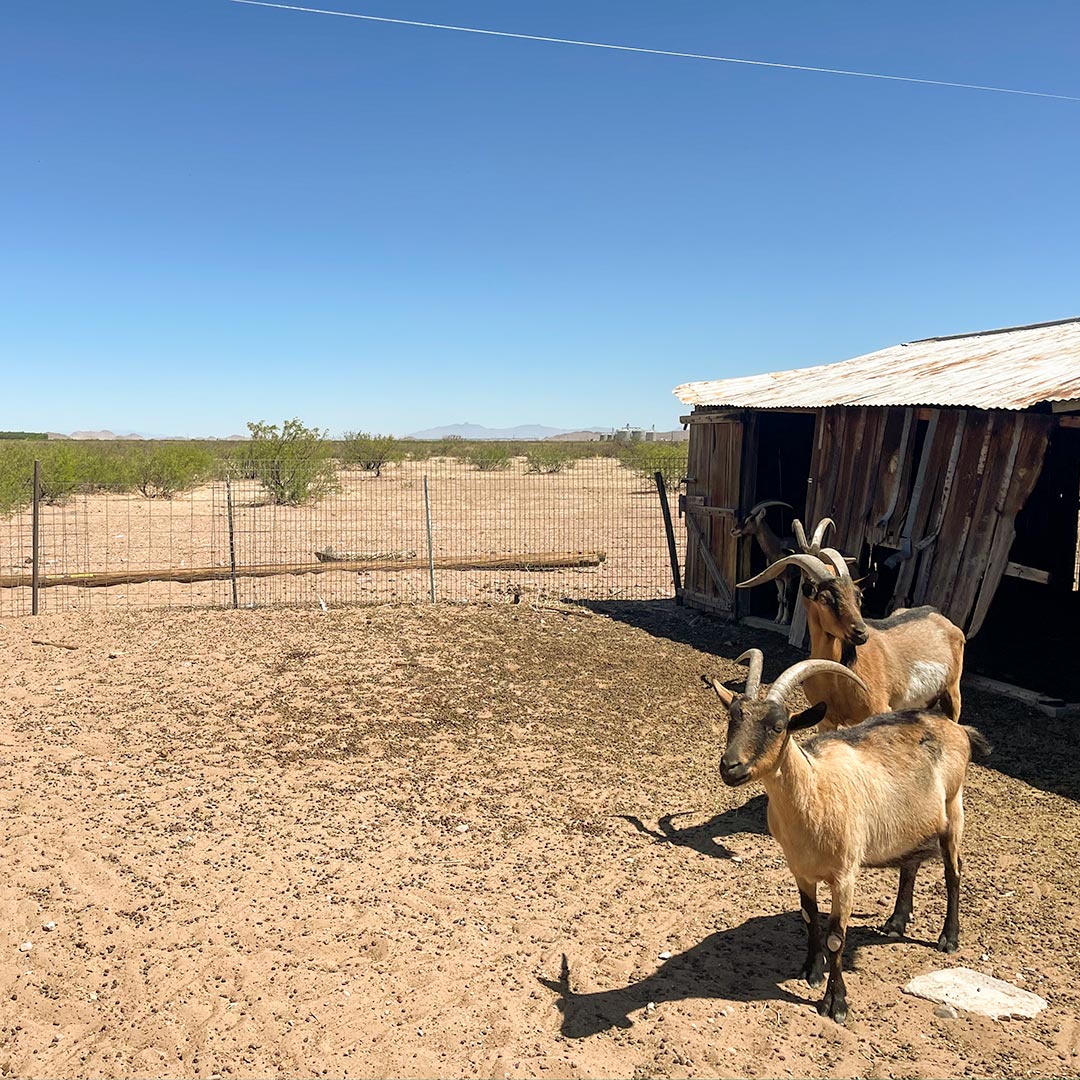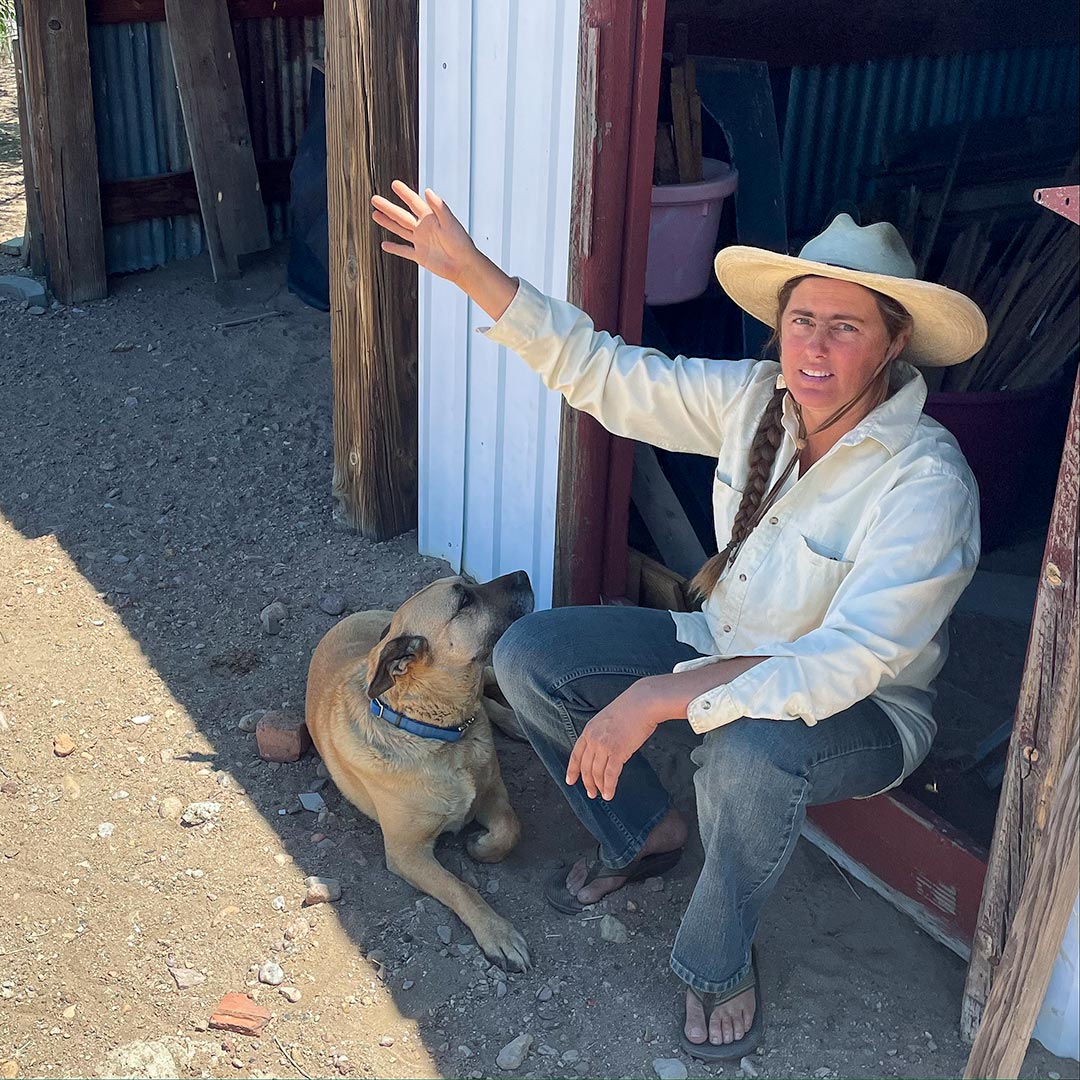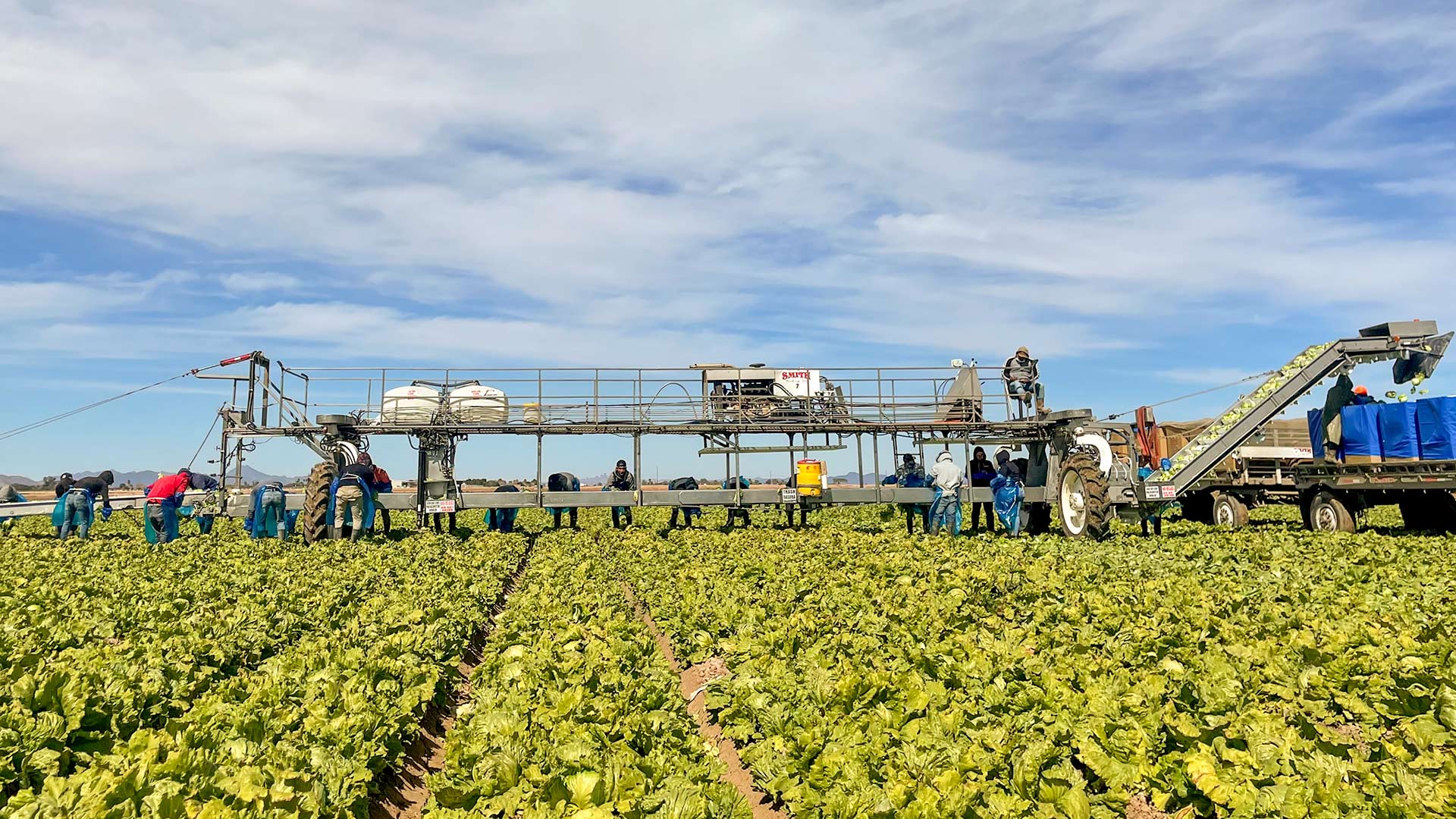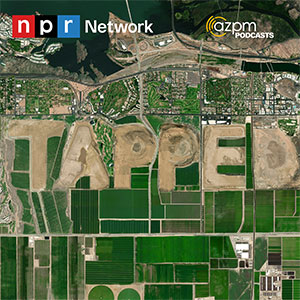“Not here for some agrarian fantasy”

The desert can be surprisingly, well, green in places. Life blooms with the smallest pool of water. And when you’re driving down the highway in Southern Arizona, sometimes you’ll drive right through a field so green, you’d think you were in Coastal California.
That can feel a little counterintuitive when you hear about climate change and water cutbacks every day on the news. But, there are a lot of reasons why those green fields are here in the desert, and one of them is pure economics.
Anastasia Rabin owns a small farm in a desert community and said it’s a lot to expect farmers to make big, expensive changes without knowing if people will ultimately buy it.
“Largely, they’re growing what they’re growing because not only is there a guaranteed market for it, but there are guaranteed subsidies for it, if it doesn’t go well,” Rabin said.
She said she’d like nothing more than to be part of a sustainable food culture, but it’s hard for her to see a way to make that possible.
“I just don't see how we're gonna get out of it.”
Arizona is built on agriculture, from small farms to huge operations. And as resources dwindle, the industry is adapting, and weighing how much it can afford to change.
 Rabin's house sits just down the road from a border checkpoint, in a corner of Arizona where water is drying up so quickly that many of her neighbors have spent tens of thousands of dollars to deepen their wells, or dig new ones altogether.
Rabin's house sits just down the road from a border checkpoint, in a corner of Arizona where water is drying up so quickly that many of her neighbors have spent tens of thousands of dollars to deepen their wells, or dig new ones altogether.
Rabin lives on a 160-acre farm in the Douglas Basin, a rural area about a two hour drive from Tucson. There’s a border checkpoint down the street from her.
I visited her on a bright, windy day in the spring. Dust was blowing in the air, and there were even dust devils in the distance.
She showed me her turkeys, a few dogs, horses and some goats. She said those goats used to be working goats. But that experiment didn’t last.
“It's really hard to think long term and decide to invest in a place where there's so much uncertainty about what could happen, like whether your well’s gonna go dry or an earth fissure is going to open up and half of your frickin house is going to fall into it.
“Or, somebody is going to move into the field across from you and start running a pump that completely destroys the quality of life and value of your property,” she said.
Rabin wears a lot of hats, both literally and figuratively.
“I do whatever I can to get by out here,” she said. “I've produced food for people. I've done some editing, I sell auto parts on eBay. Whatever it takes to get by.”
She also holds a degree in natural resource management and rangeland ecology and management. She bought this land about ten years ago.
“Most of it is just in its natural, degraded state of being some sort of pasture rangeland,” she said.
At the time she bought it, she didn’t have animals.
“I was doing some things to cover bare spots on the ground and try to get vegetation growing again, and actually came up with some pretty good strategies for doing that,” Rabin said.
And that was going well, so she brought some goats and other animals into the picture.
“I did not come here with any intention to produce food for people in Tucson. I was not acting out some agrarian fantasy.”
But she started making a few things for herself, including goat cheese, whey-fed pork, and some other animal products.
And she had very particular ideas about how the things she was doing–raising animals, making cheese and butchering–should be done.
“I think it produces a great life for the animals, and I think that it's an environmentally sensitive way of producing food,” she said.
Some of the people around Rabin took interest in the things she was making, and that’s when the whole operation ramped up.
“Some other work that I thought I had here didn't work out, and a relationship that I was in didn't work out. So, I found myself here, alone, needing to figure out a way to make a living,” she said. “And that's what I knew to do.”
That’s how a lot of small businesses get going–you start making a thing on the side, some people around you catch wise and tell you it’s good. You test it out on a few more and once you know the customers are there, you get a truck, a booth at the farmer’s market, a small catering business going. You move up little by little.
But a few years after she started, she had to quit.
“On a personal level, with the amount of work and lack of support in my day to day existence, and all of the stresses of other things going on around here, worrying about maybe my well going dry, it was just not tenable,” she said. “I couldn't keep on doing it.”
 VIEW LARGER Anastasia Rabin’s goats used to be working goats, until that work became untenable.
VIEW LARGER Anastasia Rabin’s goats used to be working goats, until that work became untenable.  VIEW LARGER Rabin says she always knew water scarcity would be an issue, even when she bought this land in Southeastern Arizona, she just didn’t expect it to be this big of a problem so soon.
VIEW LARGER Rabin says she always knew water scarcity would be an issue, even when she bought this land in Southeastern Arizona, she just didn’t expect it to be this big of a problem so soon. Her well hasn’t run dry yet, but several of her neighbors and many people in the region where she lives have had to pay tens of thousands of dollars to deepen their wells or dig new ones altogether. And she doesn’t have water rights attached to the property.
“Water scarcity was never something that I was in denial of, or didn't consider when I moved here. I just didn't expect it to happen so fast,” she said.
Many in the area put the blame on a dairy and out-of-state pecan farmers moving in and using the land in ways it wasn’t meant to be used. Mostly, they’re using lots of water, digging deeper than the residents and small farmers who were already here, and literally changing the landscape.
Drought conditions are also putting a huge strain on the land here. Rabin says that can range from lack of rain in both the winter and summer, powerful spring winds, dust storms and sediment blowing in, burying parts of her property, and covering windows and the fence line.
She says being a small farmer with an investment in the community feels like moving against the grain, and it wasn’t sustainable for her to keep doing.
“It can be easy to idealize this different kind of agriculture that we could have. And I mean, I myself would love to see things go that way,” she says.
Let’s go back to that moment in your car. Maybe you’re driving through an alfalfa field in central Arizona, or you’re on your way to San Diego, and you hit Yuma. Lettuce fields and pecan groves are on either side of the road. You hear a story on the radio about how Colorado River water is dwindling and cutbacks are coming.
And you say to yourself–why is this here?
Jeffrey Silvertooth researches agronomy and soil science at the University of Arizona, and he gets why you’d ask that.
“That's one of the most important aspects of this discussion for us to remember for typically folks that aren't working in agriculture,” he said. “They consider, ‘Why are we growing these crops? Why do we have this legacy of these crops that consume this water with us?’
“Because we do very well with those crops. Because they're well adapted. They have markets.”
To understand why agriculture looks the way it does today in Arizona, we have to go back to the 19th Century. When the United States was settling the West, it created organizations to bring more agriculture here. That included the U.S. Department of Agriculture, and land grant universities, like the U of A, which relied on income brought in by land stolen from Native Americans.
“In Arizona, the Desert Southwest, they began extensive, kind of random studies to try to find crops that were well adapted, and also had a market where you could actually grow them productively,” he said. They worked to prove you could make a living on this life to encourage settlement here.
They learned that you can grow just about anything in the desert. The old joke is you can put a stick in the ground and water it and it will sprout roots and leaves.
“But the principal crops that were identified as being viable for this region are the ones we're growing today: cotton, wheat, barley, alfalfa, corn, etc,” Silvertooth said. “Each of them fits seasonalites that are well suited to Arizona. They tolerate the heat at certain times of the year. They tolerate salinity.”
These crops also need a lot of things beyond water from the sky that Arizona is good at providing.
“You have beautiful soils. You have access to water. You have infrastructure to deliver that water. You have expertise in terms of producing those crops, which is highly specialized,” he said.
There’s another big one that George Frisvold, Silvertooth’s colleague in Agricultural and Resource Economics at the U of A, said you can’t underestimate, and you can find it in the center of the Arizona flag: year-round sun.
As we learned in the last episode, irrigation has always been a part of farming in the Southwest.
“For example, a lot of the Midwest, it's rain-fed farming,” Frisvold said. “They don't have irrigation systems, so it's whatever falls from the sky.”
He said if there’s a drought in the state and yields go down dramatically, that’s it. There have been years in Texas where about two-thirds of all the cotton acres were abandoned for that reason.
And there’s a market for what we’re already growing here.
It comes down to that moment when you’re at the store, planning what you’ll eat from week to week. You expect to see lettuce there in the winter time. The grocery store knows you’ll buy it. And Arizona grows almost all of the country’s winter lettuce.
Like Anastasia Rabin said earlier, there’s no guarantee for them that you’ll start eating a more sustainable food, like tepary beans, instead.
Even though the federal government provides subsidies to farmers–which covered about 40 percent of income to farms in 2020 and 20 percent in 2019–they only go to producers of a select few crops.
“When growers are producing things, they think in terms of what income can you generate per unit of water, so a crop that doesn't use as much water per acre, might not generate much income” Frisvold said.
Farmers care about planting what’s going to bring in enough to provide for them and their families.
Or, another way to think about it–
“I could drastically lower my carbon footprint of commuting if I quit my job, and I walked to the local fast food place and flip burgers,” Frisvold said. “I wouldn't be driving. I wouldn't be commuting.”
But that wouldn’t earn him as much money.
He said farmers here have also learned to be more water efficient out of necessity. It’s expensive to use a lot of water.
“Throughout Western history, agriculture has been using less and less water, and less and less land, and more of it goes to urban development,” he said. “We've gotten more efficient at producing things.”
Still, the drying out of the region is starting to catch up with those efforts to cut back. And agriculture accounts for about three quarters of the water used in Arizona. Frisvold said the effects of drought look different here in Arizona. It’s not through lower yields, like in Texas. It means fewer acres planted.
A lot of the state uses Colorado River water, and that water is drying up. The state’s Drought Contingency Plan kicked in this past spring, which cuts water to farmlands in Pinal County, between Phoenix and Tucson.
“Farmers have always been adapting, they're always trying new things. Agriculture has this reputation of being kind of really old timey and traditional. But folks are fairly innovative,” Frisvold said.
 Employees on Chris Mellon’s farm harvest lettuce and load it onto a truck. 90% of the countries winter lettuce comes from farms like Mellon’s here in Arizona.
Employees on Chris Mellon’s farm harvest lettuce and load it onto a truck. 90% of the countries winter lettuce comes from farms like Mellon’s here in Arizona.
Back in late February, at the tail end of the winter lettuce growing season, I went out to Yuma to visit Cory Mellon on his farm and saw his fields of lettuce. We watched his employees pick and core heads of lettuce, then stood in a field of visually satisfying rows of evenly planted spinach.
He told me his farm gets its irrigation water from the Colorado River.
“Our district distributes it through the canal system that runs through the valley. They put it in our canal system at a gate and we control it from there,” he said. “This particular field is overhead sprinkler irrigation.”
He grows a lot more than spinach here. The farm is about 6,000 acres, and it produces broccoli, cauliflower, romaine lettuce, and baby products, like spinach, arugula and mizuna.
And his operation is pretty high-tech, which like Frisvold said, isn’t unusual around here.
Mellon said his farm uses all laser control land leveling in between crops. They use GPS technology to make the rows perfectly straight, too.
“That's not just for aesthetic reasons. That's for accuracy reasons,” he said. “Because when you irrigate a field, if that furrows straight and it's deep, and it's the right depth, you can get that water to shoot across that crop just as fast as you can.”
He also uses furrow irrigation and has experimented with drip, but didn’t see a big difference between that and the sprinklers.
Mellon said that in the 76 years this farm has been in his family, it’s seen a lot of change, especially with the way water gets to the crops.
“My father and those before me, a lot of them would irrigate in different ways than we do now. “He said that meant a lot more flood irrigation. “If the crop was coming in too fast, they would irrigate it, if it was coming in too slow, they would irrigate it.”
A big difference between his farm and the cotton growers in Pinal County is that this area’s rights to Colorado River water are a lot more secure–the river is just down the road at the California border, so the farmers here have been using it for a long time.
But drought is still on his mind.
“We treat water as any other input item in a crop. The less water we can use, the more profitable we’ll be,” he said. We've been driven for years to reduce those rates of water that we're using to the bare minimum.”
He says sometimes, it’s little strange for him to drive through Phoenix or Tucson and see pools, sprinklers, grass lawns.
“The question that I guess I've had is–we've been systematically using less and less water and producing more and more crop without water input. The City of Phoenix, the City of Tucson…what is being done at the city levels to reduce water as well?”
He said, too, that he knows they’re making changes, but wonders if they’re under the same pressure that he feels.
“Then the question has to be asked, how many people can live in a desert, and sustain what they're used to with the water that we have at this point? This is a desert, it is arid, it doesn't have a whole lot of water and we have to best use the water that we have,” he said.
We’re going to try to answer his questions in a few future episodes, but before we get there, we need to talk a little more about what Arizona farmers are doing, and what’s left for them to do.
Robert Glennon has written and given a lot of talks about that. His book, Unquenchable, is about the U.S. water crisis, and what he thinks could ease the pain of it. He’s now at the College of Law at the U of A.
He has spent a lot of time in Yuma and been impressed by the massive operations and numerous trucks that bring lettuce to just about every corner of the country in the winter.
“That's not going anywhere, nor should it go anywhere,” he said. “It's one of the success stories.”
But he said farmers in Yuma could still make productive changes to the way they irrigate their fields. There have been farms in Yuma for a long time, and they have senior rights to the water supply.
“What the law in the American West has allowed is a limitless number of straws and single glass,” Glennon said. “It's a public resource, water–that's finite–but you allow finite access to it. The senior appropriators were in a position where they really didn't have to make any compromises.”
And he thinks farmers could make a few more compromises.
“There are some things they could do to use less water, such as subsurface drip irrigation. I'm a big fan of that,” he said.
Glennon also said they can’t do it alone, and they don’t necessarily have to.
The United States Department of Agriculture has several programs to help farmers in this, and Biden’s Infrastructure Act passed at the end of last year offers money as well. The Arizona legislature also passed funding this year for it.
But Glennon said more help should be on the table.
“The Colorado River is in terrible shape, across all seven basin states. The level in Lake Powell has never been so low since they first started filling the dam in the 1960s. Lake Mead is already that low,” he said. “They're not crying wolf, the cities in saying, ‘We need some water.’”
He said city or state governments should put together funds to modernize farm infrastructure. Then, farmers could grow as much product as before, and cities would get the conserved water.
And he said a little can go a long way.
“There's not a farmer in the West who can look me in the eye and say, ‘we can't do a small reduction.’ I'm talking low, single digit. I'm talking a four or five percent reduction in consumption.”
He said a reduction that size would mean a 50 percent increase in the amount available for municipal and industrial consumption.
It’s in everyone’s interest, whether it’s Rabin and her goats or Mellon on the leafy green farm, to find new solutions to the problem. But, like Mellon said, they’re not the only ones competing for water.






By submitting your comments, you hereby give AZPM the right to post your comments and potentially use them in any other form of media operated by this institution.